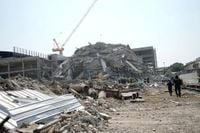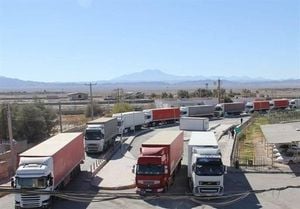A strong earthquake struck central Myanmar on March 28, 2025, causing significant destruction and panic across the region, particularly in Mandalay, the country’s second-largest city. The United States Geological Survey (USGS) reported the quake measured 7.7 on the Richter scale and was centered approximately 17.2 kilometers from Mandalay, at a depth of just 10 kilometers. As buildings collapsed and tremors were felt as far away as Bangkok, Thailand, the situation rapidly escalated into a full-blown emergency.
In Mandalay, witnesses reported multiple buildings collapsing, including a five-story structure that came crashing down in front of horrified onlookers. One local, who witnessed the disaster unfold, described the scene: "We all ran out of the house as everything started shaking. I witnessed a five-storey building collapse in front of my eyes. Everyone in my town is out on the road and no one dares to go back inside buildings." The chaos was compounded by reports of a tea shop that collapsed with several patrons still inside, and significant damage to a mosque.
Social media posts from Mandalay depicted streets littered with debris, although these reports could not be immediately verified. An officer from the Myanmar Fire Services Department indicated that search operations were underway, stating, "We have started the search and are checking for casualties and damage in Yangon. So far, we have no information yet." As the day progressed, the Myanmar military-run government declared a state of emergency across six regions, including Mandalay and the capital Naypyitaw, complicating rescue efforts amid ongoing civil unrest.
The tremors were felt strongly in Bangkok, about 1,000 kilometers to the south, where panic erupted as people rushed into the streets. Eyewitness accounts detailed scenes of chaos, with many fleeing buildings in their bathrobes and swimming costumes. One office worker described the experience, saying, "I just thought I was dizzy. All of a sudden the whole building began to move. Immediately there was screaming and a lot of panic." Buildings swayed for several minutes, and trading on the Bangkok stock exchange was halted.
In response to the earthquake, Thai authorities declared a state of emergency. Airports in Bangkok, including Suvarnabhumi and Don Mueang, were closed, and all flights were suspended due to fears of aftershocks. Rail and metro services were also severely impacted, with subways across the city shut down. As the situation developed, reports began to emerge of casualties in Bangkok, with three confirmed dead and at least 90 people reported missing after a high-rise building under construction collapsed.
Rescue efforts were hampered by unstable debris, and emergency services faced challenges due to downed power lines. A dramatic video circulating on social media showed the construction site collapsing near Bangkok’s popular Chatuchak market, where many were caught off guard. The Red Cross reported that initial assessments indicated significant damage in both Myanmar and Thailand, stating, "Initial reports from the ground suggest the earthquake has caused significant damage. Information on humanitarian needs is still being gathered."
In Mandalay, the historic Ava Bridge over the Irrawaddy River also collapsed, further disrupting transportation and communications in the area. Reports indicated that the quake caused damage to several buildings, including parts of the former royal palace. The situation was dire, with the Red Cross and other humanitarian organizations struggling to assess the full extent of the disaster.
As the day unfolded, the impact of the earthquake extended beyond Myanmar and Thailand. Tremors were felt in southwestern Yunnan province in China, prompting reports of injuries and damage in the city of Ruili near the border with Myanmar. Eyewitness accounts described scenes of chaos, with debris littering streets and emergency services responding to calls for help. A resident of Kunming, the provincial capital of Yunnan, reported that her ceiling lamp was swinging wildly during the tremors.
In light of the disaster, Thailand’s Prime Minister Paetongtarn Shinawatra convened an emergency meeting to assess the impact of the earthquake and coordinate response efforts. The greater Bangkok area, home to over 17 million residents, faced significant challenges as authorities worked to ensure public safety amid ongoing aftershocks.
The earthquake's effects were felt throughout the region, highlighting the vulnerability of densely populated cities to natural disasters. As rescue operations continue and the search for missing individuals intensifies, both Myanmar and Thailand face the daunting task of recovery in the wake of this devastating event.
As of now, the situation remains fluid, with authorities working tirelessly to gather information and provide assistance to those affected. The full extent of casualties and damage is still being assessed, but the impact of this earthquake will undoubtedly be felt for years to come.








